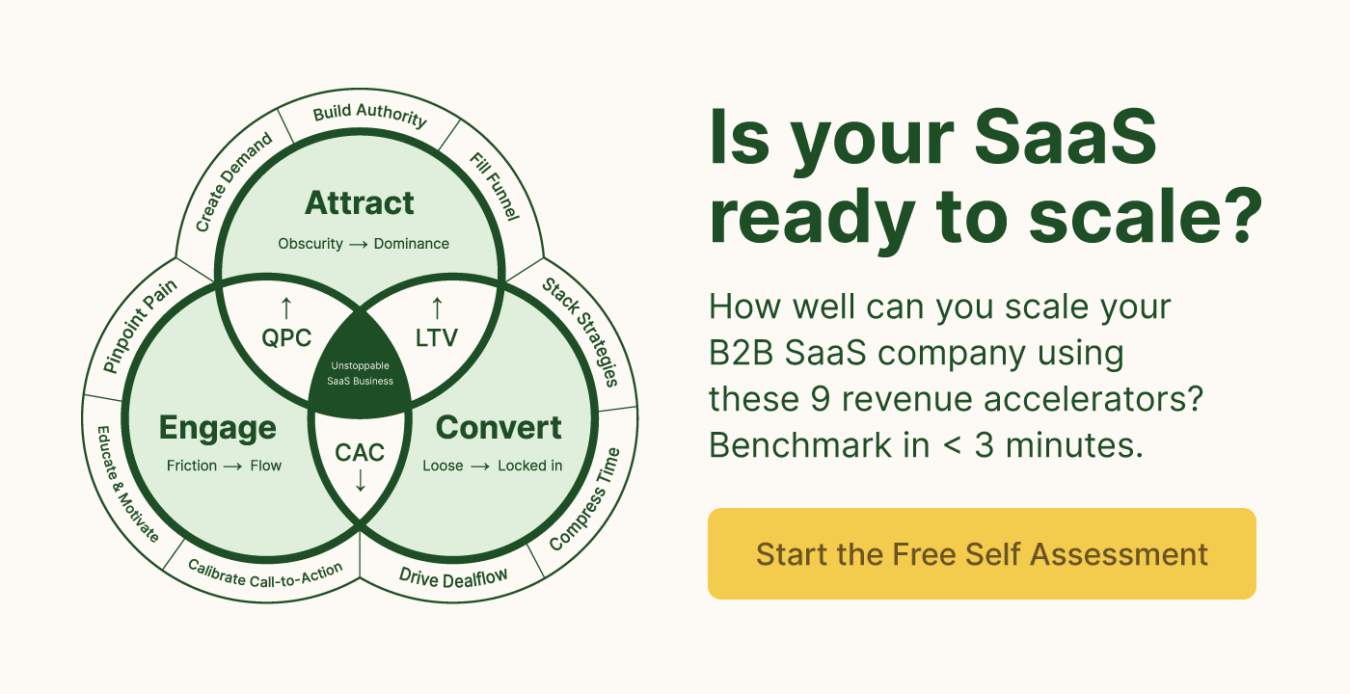The Buyer Awareness Matrix: A Content Strategy Tool for B2B SaaS
Last updated: October 3rd, 2023
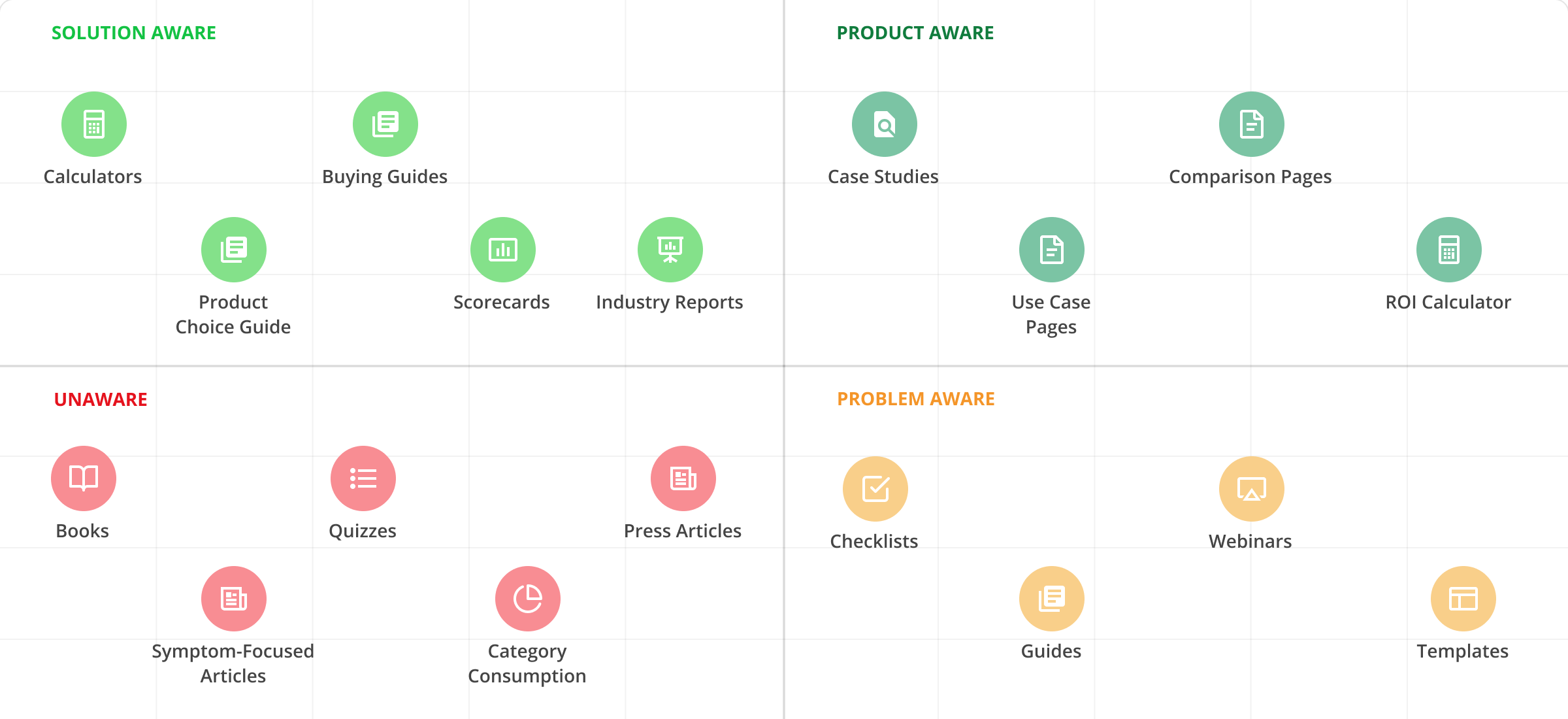
During a recent conversation, a SaaS CEO was explaining to us that he’d just hired a new head of content, and the new hire wanted to create some white papers (a common type of lead magnet in B2B SaaS).
The CEO said to us, “You mentioned that white papers are not that useful. How should we think about what pieces of content to create — and in what order?”
His desire to approach creating content strategically — paired with lacking a framework to think through how to do this — is a problem we’ve seen come up a lot for the SaaS businesses we work with.
Since they’d expressed that they’re trying to be a category creating company (i.e. a type of product that doesn’t yet exist in the market), we explained that much of their target audience would be completely unaware of the problem their product solves — and therefore unlikely to be actively looking for a solution.
At Powered By Search, we refer to this audience as an audience who is problem unaware. And when you’re in this SaaS company’s position, where much of your audience is problem unaware, it’s useful to begin with creating content that helps them become problem aware.
When we explained this, he said, “That sounds theoretically good, but I’m still not sure what kind of content works for that.”
At that point, we walked him through the types of content that we’ve found to work for SaaS audiences at four different levels of awareness:
- Problem Unaware: Audiences who aren’t aware they even have the problem your product solves.
- Problem Aware: Audiences who know they have a problem but aren’t yet aware of solutions.
- Solution Aware: Audiences who are problem aware and also know there are solutions that exist (and may be actively looking for one).
- Product Aware: Audiences who are problem and solution aware, and who are also aware of your product as a solution (potentially wanting to evaluate it).
Below, we break down our Buyer Awareness Matrix that maps out the content types we’ve found work well in each of these stages. Then, we describe how SaaS companies can think about using it based on their market type. Finally, we wrap up with our recommendations for putting this tool to actual use.
Our philosophy on content is that it’s not about quantity — it’s about offering the right types of content at the right times to guide audiences through the buyer’s journey. If you’re a B2B SaaS business that would like to learn about how we can help you with this, schedule a Free SaaS Scale Session here.
The Buyer Awareness Matrix, Explained
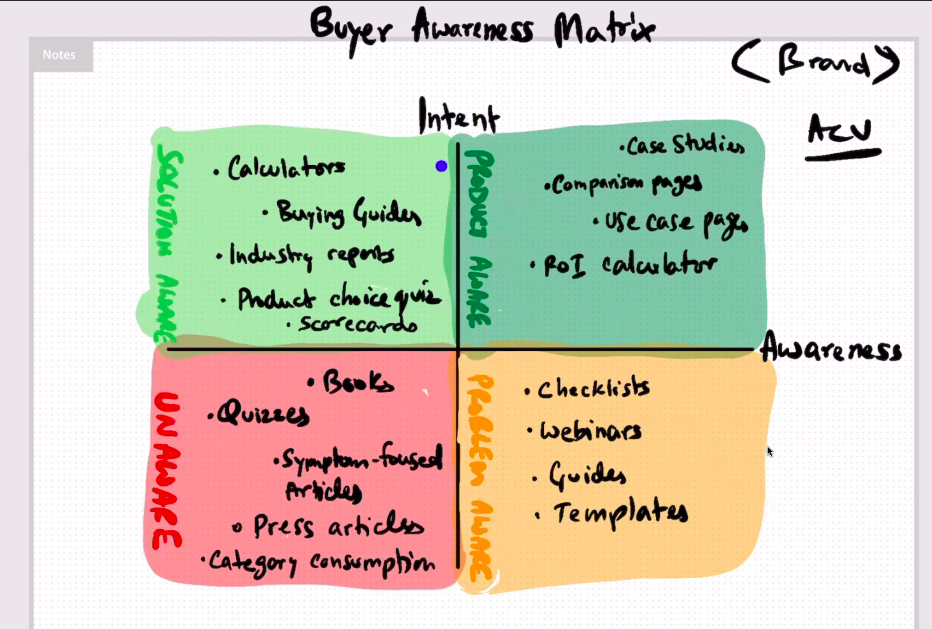
This simple grid represents the four different levels of audience awareness that we described above, each with a list of content types to create for audiences at that level.
The function of content in each category is to help move audiences to the next level of awareness. And commercial or purchase intent increases as audiences move from unaware to problem aware, to solution aware, and eventually to product aware.
Note: Moving through the various levels of awareness is the equivalent of moving down the funnel. So you can think of content in the problem-unaware quadrant as top-of-funnel content and content in the product-aware quadrant as bottom-of-the-funnel content.
The following content types are what we’ve found to work best at each level:
- Problem Unaware Content: Books, Quizzes, Symptom-Focused Articles, Press Articles, Category Consumption (content that goes through the why, what, how, and what to do next regarding your product category)
- Problem Aware Content: Checklists, Webinars, Guides, Templates
- Solution Aware Content: Calculators, Buying Guides, Industry Reports, Product Choice Quizzes, Scorecards
- Product Aware Content: Case Studies, Comparison Pages, Use Case Pages, ROI Calculators
Fundamentally, some of these content types are foundational elements of any well-designed SaaS website. For example, use case pages are typically built into the architecture of a site. And case studies are also typically present, as it’s well understood that they’re necessary for demonstrating value to prospects.
Beyond these, there is a lot of flexibility in which types of content you choose to create from the matrix.
An ideal mix for any SaaS company should include (at minimum) something from each category. That way you have at least some content asset that can guide any ideal prospect to the next step in the journey (regardless of their initial level of awareness or purchase intent).
When it comes to which types of content a given company should choose and in which order, it’s useful to take into account the market you’re in.
Creating Content Strategically Based on Your Market
What follows is our recommended approach to content creation for companies in three common scenarios:
- Creating content for established markets.
- Creating content for new markets (category creating products).
- Creating content when a company wants to move upmarket.
Creating Content for Established Markets
In established markets, much of your target audience will be problem or solution aware, and helping them become product aware (aware of your product as a solution) takes higher priority.
For example, if you make accounting software, there is less need to focus on educating people about the problems it solves, because it’s widely known that using accounting software is a fundamental necessity for doing business. There is more need to focus on showing up in search results when people are actively looking for and weighing solutions — so content like case studies, use case pages, and competitor comparison pages should be created first.
Our article on B2B SaaS content strategy describes our approach to content creation for companies in established markets, beginning with bottom-of-the-funnel (BOTF) content for people in the solution and product aware stages, and exhausting those options before moving up to mid- and top-of-funnel content (equivalent to the content types listed in the Problem Unaware and Problem Aware sections of the matrix).
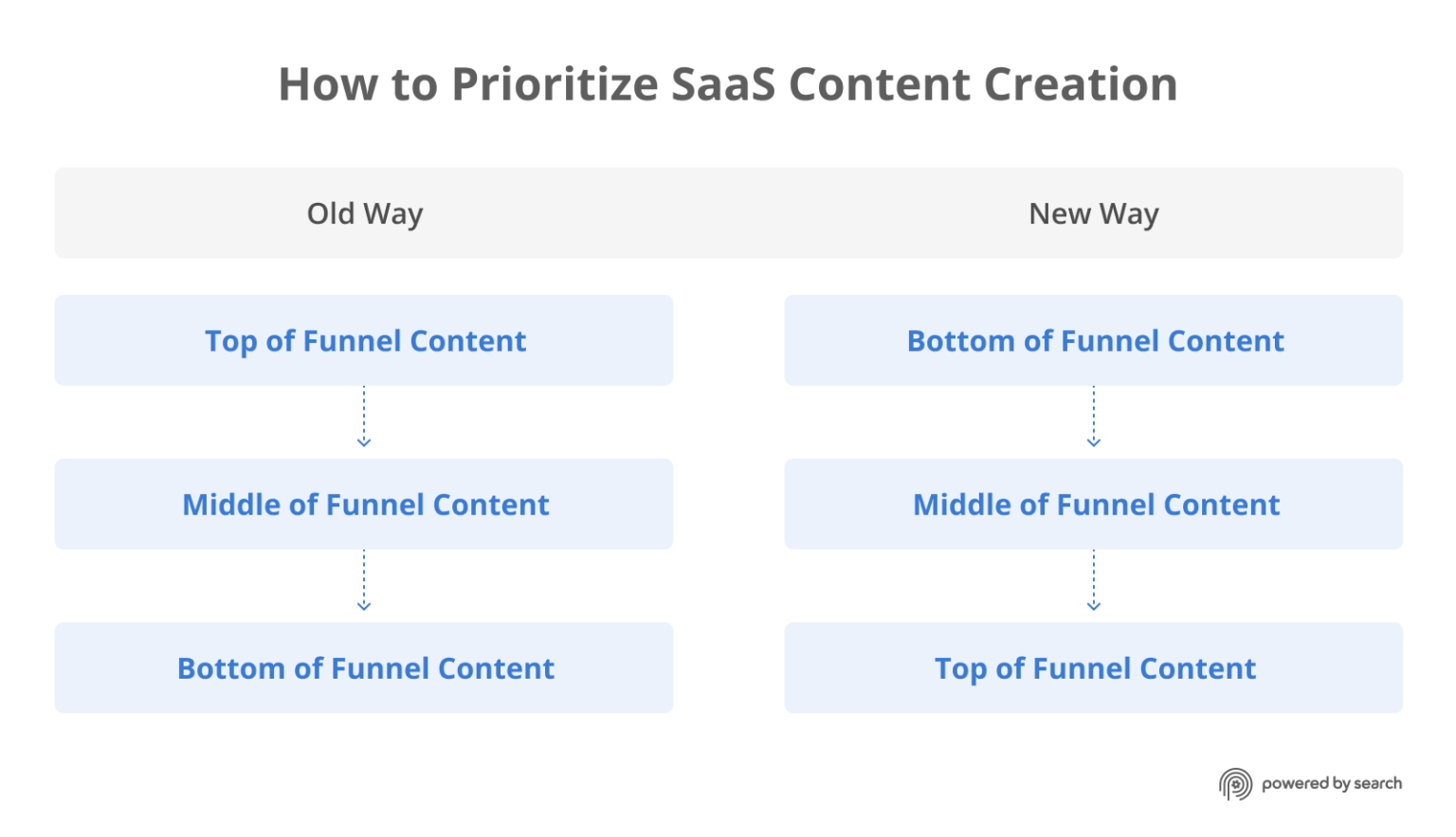
However, if your SaaS is a category creating product, a reordering of this approach is a better fit.
Creating Content for New Markets (Category Creating Products)
When you’re in a position like the SaaS CEO we discussed above, where you’re creating a new category of product all together, it’s likely that much of your target audience is unaware they have a problem, and therefore unlikely to be seeking a solution.
In this case, creating problem unaware content (top of funnel content to educate consumers about the problem your product solves) takes the highest priority in the beginning. So companies in this situation should start with creating at least one or two content assets in that category.
We typically lean towards creating symptoms-focused articles or quizzes at this stage. For example, take this lead magnet we created for our previous client Restaurant Systems Pro:
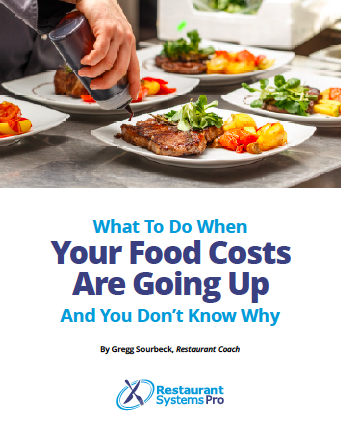
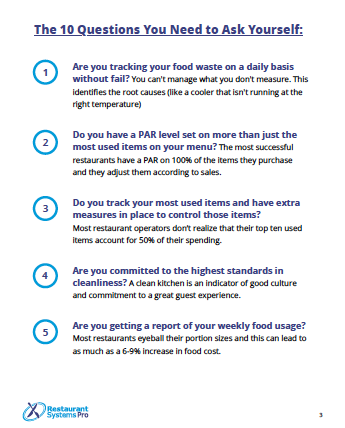
This was a downloadable PDF lead magnet we created for the problem-unaware folks in their audience. It’s pain-point focused and designed to help restaurant owners and managers self-diagnose the problems they experience around managing food costs — the specific problems their product helps to solve.
Then, once your problem unaware content is created, we recommend moving back up to the product aware (BOTF) content you’ll need to close customers (e.g. case studies). Lastly, you’d move to create mid-funnel content (the types listed in the problem- and solution-aware categories).
Creating Content When You’re Moving Upmarket
Another common situation we see is when SaaS companies are seeking to move upmarket to serve more enterprise clients. And the challenge is that, even for the enterprise companies who are problem or solution aware, they aren’t yet aware of your product as a potential solution.
In addition, since they’ve typically been serving smaller or medium-sized companies, they may not have enterprise case studies to demonstrate the effectiveness of their product for companies of that size.
In this case, our recommended approach would be to start with either problem- or solution-aware (mid-funnel) content, with the objective of moving enterprise prospects to become product aware. Then, as you acquire your first enterprise customers, you can begin to build out better BOTF content such as case studies; similar to the approach with established markets, top-of-funnel (problem-unaware) content would come last.
Synthesis: Recommendations for Using the Matrix In Practice
Here’s a simple way you can use this matrix:
- Take stock of the content assets you have, and note them down in the corresponding sections of the matrix (using a darker color to indicate it’s something you already have).
- Fill out the other content types in a lighter color (indicating the content assets you don’t yet have).
- Consider your market type and position when choosing in which order to update previously created content or create new content.
- Go forth and update your previous content (unless the quality is already very high) or create new content.
In general, whenever you can update previously created content, lean into that as opposed to creating content from scratch. That will require less effort and be the most efficient option if you happen to have some of these assets already.
From there, deploy the content through the marketing channels where you’ve found customer-channel fit, and leverage omnichannel remarketing to drive right-fit prospects to your content and lead them down the funnel.
Conclusion
In following this process of using the Buyer Awareness Matrix, you can increase the likelihood of delivering content to your audience that will actually fit their stage in the buyer’s journey — and therefore be more likely to guide them to the next desired stage. At the same time, you can decrease the likelihood of delivering content to the right people, but in the wrong way at the wrong time.
If you’re a B2B SaaS business that would like to learn about how we can help you develop and deploy compelling content assets that generate new leads and signups, schedule a Free SaaS Scale Session.
What you should do now
Whenever you’re ready…here are 4 ways we can help you grow your B2B software or technology business:
- Claim your Free Marketing Plan. If you’d like to work with us to turn your website into your best demo and trial acquisition platform, claim your FREE Marketing Plan. One of our growth experts will understand your current demand generation situation, and then suggest practical digital marketing strategies to hit your pipeline targets with certainty and predictability.
- If you’d like to learn the exact demand strategies we use for free, go to our blog or visit our resources section, where you can download guides, calculators, and templates we use for our most successful clients.
- If you’d like to work with other experts on our team or learn why we have off the charts team member satisfaction score, then see our Careers page.
- If you know another marketer who’d enjoy reading this page, share it with them via email, Linkedin, Twitter, or Facebook.
